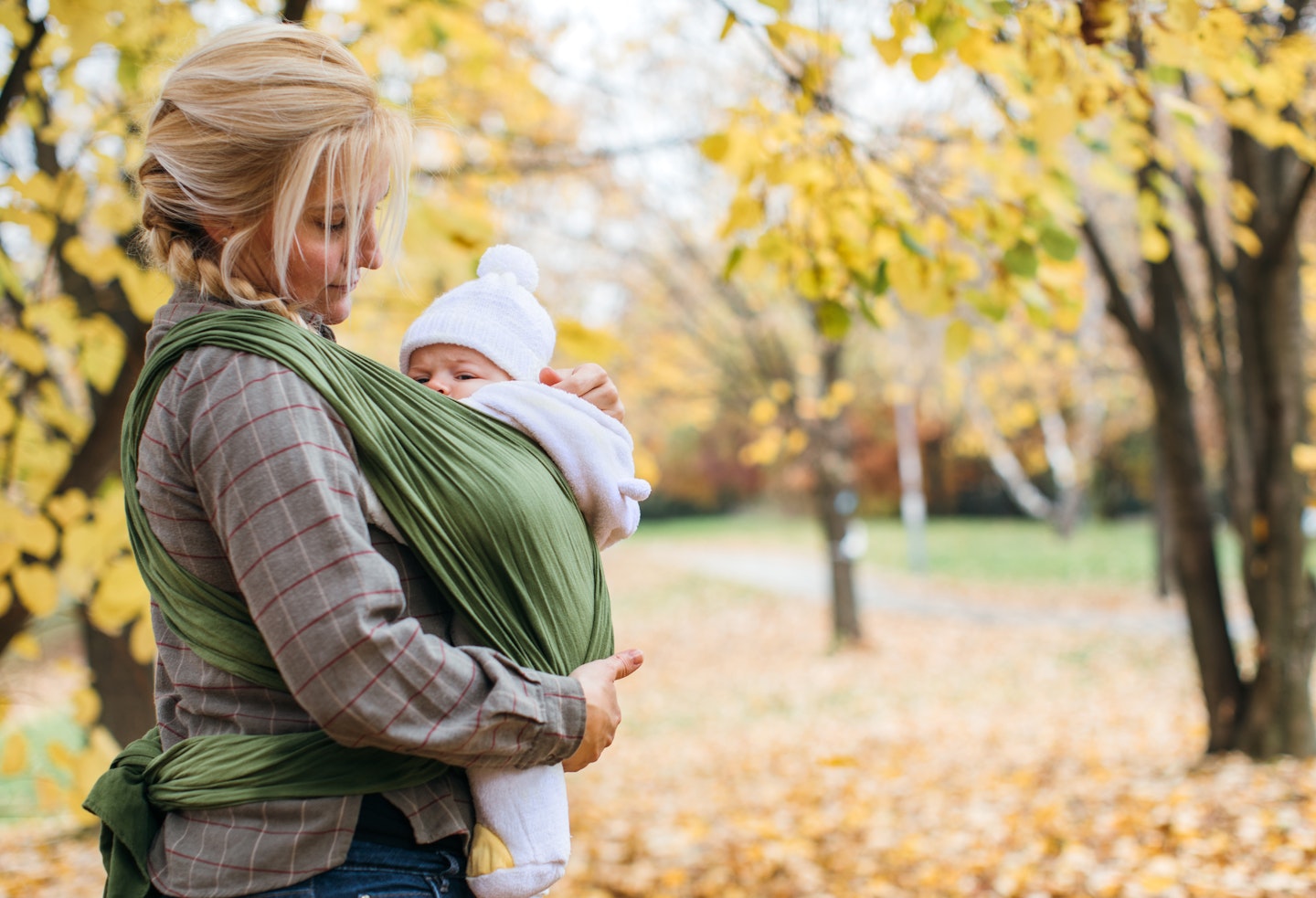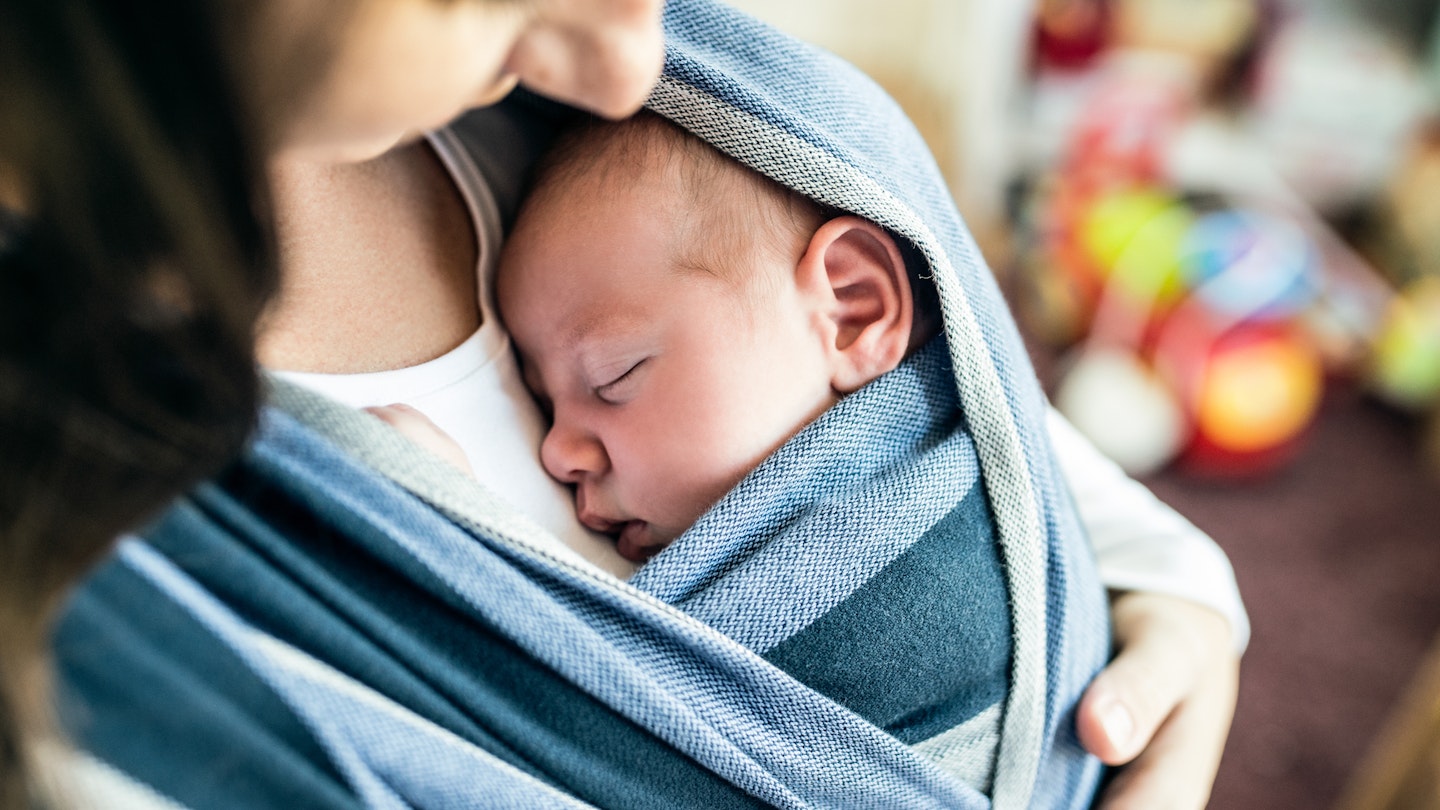Wondering if babywearing is for you? Or what on earth to do with all that fabric?
In this article:
Constant cuddles and the gift of reclaiming your hands – it’s no wonder babywearing is growing in popularity in the UK! Slings and baby carriers are a great source of comfort to your baby – by being kept close to you he can hear your heartbeat and feel your body warmth, while your movement mimics the comforting rocking motion he felt when he was in your womb, to help keep him calm.
More related expert articles from Motherandbaby.com
But they’re about convenience too – no one enjoys manoeuvring a pram onto public transport or around busy shops and cafés, and carrying your baby or toddler in your arms can quickly become heavy and uncomfortable. But with many types of carrier available, it can be hard to know which one to try, and a bad first experience can leave you wondering whether babywearing is really right for you after all.
Why carry?
Babywearing is an effective way of comforting an upset baby but it can have a relaxing effect on you as well. Being close to your baby triggers your brain to release the hormone oxytocin, which will help you to feel calm and content. According to Dr Rosie Knowles GP, carrying consultant and author of Why Babywearing Matters, and a mum of two; carryingmatters.co.uk ‘Mums feel better for the cuddles, but also because they become confident that they can calm their baby, meet his needs and still be hands-free to do what they want to. Babywearing is an age-old practice that helps life to work.’
A study carried out at Columbia University in New York found that using a soft baby carrier from an early age helped promote a strong and secure attachment between mothers and their babies. It concluded that the increased physical contact created from using carriers made mothers more responsive to
their baby’s needs, which helped to promote bonding. Some mums worry that babywearing could discourage their child from being independent and hold back their physical development, but Rosie says the opposite is actually true.
-
Read more about how to bond with your baby.
'Building a happy brain that is confident and secure is essential to a child’s long-term wellbeing,’ she says. ‘Most people who carry their children a lot in the early months find that this helps them feel more able to explore the world around them, as they are very sure of their parent being there when they need them.’
-
Real mum tip: ‘Let other family members bond through babywearing, too – my husband really enjoys it.’ Vicky Williams, 29, from Sheffield, is mum to Rupert, 18 months, and Clover, three, and is expecting her third child.
Safety when babywearing
Make sure your baby is safe in his carrier by following the TICKS rule:
-
T is for Tight. Your carrier should be close fitting to make sure it holds your baby in a safe position.
-
I is for In view at all times. Make sure you can clearly see your baby’s face so you can check on him easily.
-
C is for Close enough to kiss. You should be able to kiss the top of your baby’s head easily while he is in the carrier, but make sure he can still move his head freely.
-
K is for Keep chin off chest. ‘His chin should be off his chest and his airway open and unobstructed, and remain so if he falls asleep,’ says Rosie.
-
S is for Supported back. ‘The sling should be snug so baby’s chest and back are well supported, with no slumping or sliding downwards,’ says Rosie.
How to use a baby wrap
It can be pretty tricky to get the hang of using a baby wrap, but this mama has made it look like a breeze! As you can see from the video, she is always making the wrap is tied tightly around her to make sure baby is safe and secure.
-
Take a look at our guide to the best baby slings
Babywearing has also been found to benefit breastfeeding. A study carried out in Italy in 2012 found infants who spent at least an hour a day in a baby carrier during the first month breastfed more frequently at two and five months than those who weren’t carried. One of the reasons babywearing can help breastfeeding is that it promotes skin-to-skin contact, which boosts levels of the hormones oxytocin and prolactin, both of which play an important role in ensuring he’s ready for his next feed before he becomes hungry and upset.
-
Read our beginner's guide to breastfeeding.
There are health benefits, too. Close contact helps regulate your baby’s temperature, breathing and heart rate, but carrying your
baby can also feel like a lifesaver if your baby suffers from colic, reflux or constipation. This is because an effective baby carrier holds your baby upright with his legs in an M position – where his knees are higher than his bottom – a position which promotes healthy digestion.
-
Want to know more about baby digestion? Read more: Green baby poop: why bright green is bad & your poop colour chart
‘Babies with colic can be hard to soothe, but the motion gained from being gently rocked while the parent walks often helps to settle them,’ says Rosie. ‘A good carrier encourages an upright position, which can reduce posseting and reflux, and a spread squat position helps aid bowel elimination.’ With all these benefits to be gained, your next step is finding the right carrier for you…
How to find the right carrier for you

Follow our quiz to find which carrier is right for you.
How old is your child?
-
Under four months
-
Four to 12 months
-
12 months or older
Are you good at following instructions?
-
Yes, so long as I have clear guidance or a good YouTube video to follow
-
I like things to be quick and simple, so I can master them easily
-
I’m pretty confident at having a go at most things
What do you want to use your carrier for?
-
I want something my baby will settle easily in and which I can breastfeed in
-
Practical things like going for a long walk and getting stuff done around the house
-
Carrying my toddler when his legs are getting tired
Mostly 1's:
Many parents with young babies find a stretchy wrap a good option. It’s soft and comfortable and offers good support to your little one, so he doesn’t need to have good head control. Some find the wrapping technique confusing, and it can be tricky to get right at first.
Watch plenty of online tutorials to help you get started, or get advice from your local sling library. Or look for a newborn buckle carrier made of softer
fabric, which can be adjusted to fit your baby perfectly.
Mostly 2's:
Soft structured baby carriers or buckle carriers are quick and simple to use, and can be easily adjusted for different people or as your baby grows. Buckle carriers are ideal for babies who have good head control, but some are suitable from birth; others may need an additional insert to be used for newborns. It can be difficult to breastfeed in a soft structured carrier.
Ring slings (a piece of fabric fed through two rings) are also easy to use and are ideal for breastfeeding in, however, they can be a little uncomfortable if worn for long periods, as they don’t necessarily distribute your child’s weight evenly.
Mostly 3's:
Toddler versions of soft structured carriers are available and allow you to carry your little one on either your front or back when his legs get tired. These allow for facing you or outward facing, which helps keep wriggly, nosy toddlers entertained. They often come in a variety of materials, including lighter, mesh fabrics so that your child doesn’t get sweaty.
Ring slings can also be used for toddlers and can be folded up easily and popped into your change bag so it’s there when you need it. Some prefer to use rucksack-style back carriers for older children, but these can be very heavy and tend to take up lots of space.
Meet the expert
Dr Rosie Knowles is a GP, carrying consultant, author of Why Babywearing Matters, and a mum of two; carryingmatters.co.uk
Carrying consultant Rosie knows only too well that getting to grips with baby carriers can be a confusing business. She quickly stopped using the first two carriers she tried with her son more than 10 years ago, and it took perseverance to find the one which worked best for her, a journey that inspired her to start offering babywearing support to others.
‘I loved being able to have my child close, to talk to him and communicate easily,’ she says. ‘I am deaf, and lip read, so being able to feel him beginning to make noises meant I could be responsive quickly and meet his needs before he became really upset.’
Have approx 60 seconds to spare? Why not join thousands of mums-to-be and start your very own Amazon baby wish list! They're absolutely free to create and perfect to send to the friends, aunties and your mum to make sure you're getting the baby products you really need...Click here!
